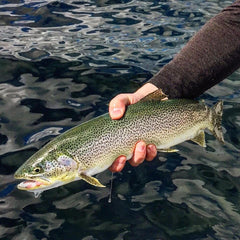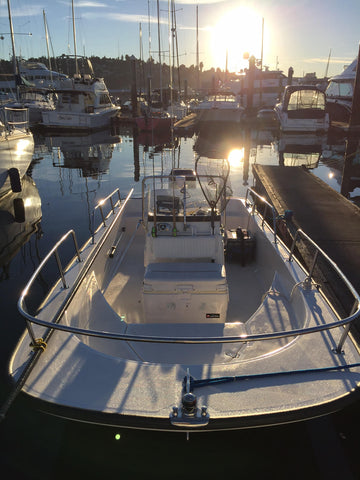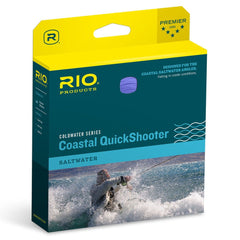 For over a decade I have been a Puget Sound cutthroat guide. As a lifelong angler, the one aspect of this sport that has fascinated me more than anything is fly line design. I am pretty sure I have cast the majority of lines that have come to the market in my 13 years at Pacific Fly Fishers. In that time I have always “settled” for line choices in the Puget Sound cutthroat and salmon world. The two main fly line factors involved with this type of fishery are distance and sink rate. I stand strong in my belief that a full intermediate sinking fly line will produce better results than any floating or sink tip line. It is also the way I like to fish. The problem with a line such as the Rio Aqualux is that larger salmon flies do not turn over well and the distance is limited to the casters ability. Enter the shooting head fly line. This is a perfect option for the angler who wants easy distance but it is difficult to maintain loop stability and control with hardly any back taper on this style of line.
For over a decade I have been a Puget Sound cutthroat guide. As a lifelong angler, the one aspect of this sport that has fascinated me more than anything is fly line design. I am pretty sure I have cast the majority of lines that have come to the market in my 13 years at Pacific Fly Fishers. In that time I have always “settled” for line choices in the Puget Sound cutthroat and salmon world. The two main fly line factors involved with this type of fishery are distance and sink rate. I stand strong in my belief that a full intermediate sinking fly line will produce better results than any floating or sink tip line. It is also the way I like to fish. The problem with a line such as the Rio Aqualux is that larger salmon flies do not turn over well and the distance is limited to the casters ability. Enter the shooting head fly line. This is a perfect option for the angler who wants easy distance but it is difficult to maintain loop stability and control with hardly any back taper on this style of line.
Yes, the Scientific Anglers Streamer Express was awesome and my first choice for many years as was the RIO OutBound in all its variations. However, the back taper was lacking or nonexistent. The number one attribute people ask for when selecting a line for this fishery is power. We want to launch flies into the nether regions of Puget Sound and do so with 20 MPH winds in our face. So naturally this line choice was perfect, a short but large diameter head to turn over large, wind resistant flies. What we compromised on was accuracy and long controlled casts.
So when John Harder of RIO Products walked into Pacific Fly Fishers to talk fly lines I mentioned this dilemma. We talked about tapers, we talked about both good and new casters, and we talked about coatings, cores and sink rates. Really, we came up with the questions that needed answers.
How do we design a fly line that will cast like a “trout taper” but have the power of a shooting head?
How do we do so in a full intermediate sink rate with a clear head?
I waited in high anticipation for the geniuses at RIO to get something on paper. Instead, the first prototype arrived a few months later.
 Generation 1 - Came back with a slightly longer back taper then we had in mind. This was a great start to our ideas.
Generation 1 - Came back with a slightly longer back taper then we had in mind. This was a great start to our ideas.
Generation 2 - Was perfect in design. The overall taper was accurate and the short but powerful front taper was a dream to hit 40 feet with two false casts and the slightly longer back taper was easy to lengthen out to 70+ feet for controlled casts. The intermediate sink rate was consistent and uniform throughout the line. However, the running line would heat up on the boat deck and get sticky and tangle.
Generation 3 - A hardening of the coating on the running line was implemented. This will help with a hot boat deck and allow for better shoot-ability on boat or beach.
Project lead, Jesse Robbins of RIO/Sage and I took the prototypes plus OutBounds (short and long), Streamer Express and a few other lines on the boat for some testing. Hard work, eh? After a full day of casting everything and re-lining reels, the conclusion was evident to both of us. The overall ease of use and the technical attributes we wanted were all met by generation 3. The Coastal QuickShooter was born.
Testing Conditions:
• Calm water
• Late August temperatures
• 5-6 foot fluorocarbon leader
• Flies: 2-3” un-weighted baitfish patterns, weighted Clouser Minnows
• Depth fished: 2-12 inches + 3-5 feet + 6-11 feet
• All casting was done from the boat deck
• Ease of cast at 30, 40, 60, 90 feet
• How the line tracked in the air, both front end (tip) and back end taper. Did the tip dive down as the line was cast?
• Line pick up and one-shot re-casts
• All lines were cast both with/without hauling as to put the taper to work.
• Rods used: Sage SALT, Sage ONE, Sage Z-Axis, Sage VXP, Winston SX -- All in 5-6 weights.
 The last question to answer was running line color. The traditional Aqualux color would blend into the skyline making it difficult to see. As a guide I need to be able to see the line in the water and in the air to have the ability to adjust the anglers cast. We went through a few colors and ended with chartreuse. A highly visible color to any background yet darkens (slightly) in the water when fished.
The last question to answer was running line color. The traditional Aqualux color would blend into the skyline making it difficult to see. As a guide I need to be able to see the line in the water and in the air to have the ability to adjust the anglers cast. We went through a few colors and ended with chartreuse. A highly visible color to any background yet darkens (slightly) in the water when fished.
It is my opinion that the RIO Coastal Quickshooter is the ultimate taper for sea run fish in cold coastal waters. Furthermore, it is a line both new casters and advanced casters will enjoy.
This project was a ton of fun to work on. It really shows the passion RIO has to all fly fishing situations. They even listened to a coastal cutthroat guide on Puget Sound wanting a line for a very specific fishery.
Thank you RIO,
Capt. Ben Zander

